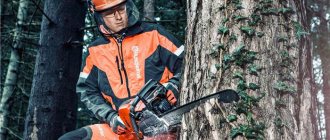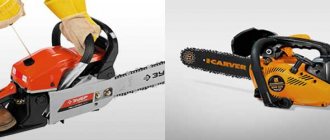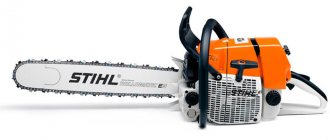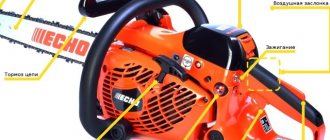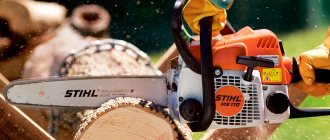A chainsaw is a technically complex and dangerous tool, for this reason, when working with a saw you must follow certain rules. Inexperienced users often treat working with a chainsaw with less attention and violate the rules, which leads to injury to the operator or damage to the tool.
In this article, we will look at how to properly prepare a chainsaw for work, what are the rules and methods for felling and sawing trees, we will talk about how to cut with a chainsaw correctly, and we will specifically focus on safety precautions.
Preparing for work
The first thing to start working with a chainsaw is its assembly. The assembly diagram of different models is practically the same. The saw bar and chain are installed on the saw, and the chain is tensioned.
The chain can be considered correctly tensioned if it does not sag on the bar and can be easily turned by hand. If you have to apply too much force to turn the chain, it means it is too tight and you should loosen its tension a little.
Next, you need to check the sharpening of the chain; for this, the cutting edge of each working tooth is visually inspected. The edges must be smooth without dents or nicks.
The next step is refueling the chainsaw. The fuel mixture is prepared in a certain proportion, which can be found by reading the user manual supplied with the saw. Basically, the fuel mixture is diluted in a ratio of 1:50, that is, for one liter of AI-92 gasoline, you need to add 20 grams of oil for two-stroke engines.
Important: when pouring fuel and oil for chain lubrication into the tanks, you need to be extremely careful and not mix them up. If you pour oil into the fuel mixture tank, the chainsaw will not work. To restore functionality, you will need to flush the fuel tank with gasoline, as well as clean the fuel line and carburetor, which is quite difficult.
What do you need to know first?
There are a range of factors that influence the correct felling of timber. The most important conditions are divided into two categories: the technical component of the process and ensuring the safety of all persons involved.
The technical side of the issue usually requires an immediate solution when choosing a chainsaw, since each model is designed only for a certain thickness, density and structure of wood. Sawing is usually done quite slowly. Acceleration is only possible when working with well-yielding wood or thin trunks (you can even use a mini chainsaw for this). Usually such plants are not of great value, so they are cut down very rarely.
You need to take into account the thickness of the tree in advance , comparing it with the selected chainsaw model (see rating of the best chainsaws). The device must optimally meet a specific power goal. If the length of the device’s tire does not exceed 35 cm, then the maximum diameter of the tree trunk with which the work is carried out is 30 cm. When the length of the tire reaches 65 cm, then you can cut down options up to 60 cm in diameter.
For the most massive types of wood, complex and very powerful chainsaws are used (see the most reliable chainsaws), which exceed the standard weight. The length of the tire in them is above 65 cm.
The sawing technology also changes along with the thickness of the target. One cut can reliably cut down trees up to 20 cm in diameter. If this indicator exceeds this threshold, you need to make several cuts in order to cut down the tree without damaging the device and without much effort on the part of the workers.
Russian-made chainsaws are no worse than foreign ones in many respects.
Chainsaw Lesnik meets all international standards for quality and safety.
The Ural chainsaw is very easy to use and therefore popular among consumers.
The greater the height of the tree, the more problematic compliance with safety regulations becomes . Sawing also becomes more difficult, since greater weight requires some effort and greater power of the device. Sometimes you have to make cuts in a group, maintaining a level distance, that is, making them at different heights.
Tree felling tools
In order to fell a tree in a certain direction, professional fellers and others use special tools. The most common of them are felling forks, wedges and blades. Special hydraulic or mechanical jacks can also be used.
Wedges can be made from wood directly at the felling site or purchased in specialized stores. Wedges made of polymer materials are widely used, the size of which is selected depending on the diameter of the tree being cut.
In order to have an idea about felling jacks, we recommend watching a video that shows how, using this device, a lumberjack cuts down and lays a pine tree in the direction he needs.
Felling blades work on the principle of a wedge, only they have a lever, thanks to which the operator can increase the force and help the tree fall in the desired direction. The principle of operation of the felling blade or also called the lever can be found out by watching the video below.
Cutting down trees on plots owned by other individuals or legal entities
In this case, cutting down the tree is also possible. But there must be good reasons to carry out this manipulation. Here are the main ones:
- If the tree is located directly at the border of the neighboring property and interferes with neighboring property owners. The regulated distances in this case are: for medium-sized plantings - 2 m, for tall plantings - 4 m, for shrubs - 1 m.
- When a plant, due to its decay, threatens people or the integrity of buildings.
- Also, cutting down someone else's tree can be done if the overgrown crown blocks the light entering the windows of apartment buildings.
Feller position
In order to avoid injury when cutting down a tree, the feller must always choose the correct position. The correct position is considered to be one in which the feller can escape from danger at any time. For this reason, before felling trees, the operator should clear away any small growth that could cause a tripping hazard. When felling, you need to hold the saw with both hands and be in the area opposite to where you plan to fell the tree.
It is allowed to be in the area of a falling tree only to cut out a wedge, which is done first.
Apple tree pruning diagram for beginners
How to properly trim apple tree branches in spring?
In the spring, the main tasks of the gardener are to eliminate the consequences of overwintering apple trees and prepare them for the new season. Sanitary pruning is carried out, young apple trees form:
- All broken, burned and frostbitten branches are removed;
- Branches severely damaged by infections or pests are completely destroyed;
- Branches that grow inside the crown and form an acute angle with the trunk are removed;
- Old trees can be rejuvenated;
- Strong or medium regulatory pruning is carried out if necessary.
By carrying out regulatory pruning in the spring, you can control the amount of harvest. If the previous year the tree produced a large harvest, it laid some flower buds. In this case, spring regulatory pruning will not be necessary.
If the previous year was not rich in harvest, then in the spring the tree should be pruned quite heavily. This way the apple tree will have as many fruits as it can grow without spending excessive effort.
How to prune apple trees in summer?
Drastic pruning is possible only as a reaction to negative natural phenomena.
- The beginning of summer is the time to remove diseased branches if the extent of their damage was not visible in the spring;
- End of June - pinch the rapidly growing green shoots so that they do not take away nutrition from the main skeleton of the plant and do not shade the crown;
- At any time, those branches that have broken or cracked under the influence of natural factors or the severity of the harvest are pruned;
- End of summer - old branches of adult plants on which few apples have formed and those that shade young fruit-bearing branches are removed;
- Late summer - prune fruit-bearing trees to slow down the start of the growing season next season, if necessary.
If there are no sick or broken branches on the apple trees, in the summer you can limit yourself to only pruning that regulates the density of the crown. Knowing how to prune your apple tree during the summer months will help you achieve a successful harvest.
How to prune apple trees in the fall?
In late autumn, you can do all the pruning work that you didn’t have time for in spring and summer:
- Branches broken by the wind are removed;
- Branches that have broken or cracked under the weight of fruit are removed;
- After fruiting, sanitary pruning is carried out to get rid of the consequences of harvesting;
- Rejuvenating pruning of old apple trees is carried out;
- If, during the fruiting period, branches were noticed on adult apple trees on which there was practically no harvest, they should be removed;
- The branches on which small and deformed fruits have grown are removed;
- Branches that shade the main fruit-bearing shoots are removed;
- Branches that are heavily damaged by pests, bacterial or fungal infections are removed.
Advice! There is no universal pruning scheme; focus on the individual needs of each apple tree.
The need for pruning depends on many factors. One of them is the age of the orchard.
Safety precautions and personal protective equipment
A chain saw is a source of increased danger; working with it requires compliance with certain rules.
- The operator must be in normal condition when working with the tool. It is prohibited to use a chainsaw while under the influence of alcohol or drugs.
- It is forbidden to touch the saw attachment with your hands while the engine of the chainsaw is running.
- To prevent sawdust from getting into the eyes, the operator should wear safety glasses or use a face shield when using the saw.
- The chainsaw operates loudly, so it is necessary to take care of hearing protection. Use headphones or special earplugs.
- During the process of felling a tree, there is a risk of dry branches falling on the operator, so the work must be done in a helmet or hard hat.
- Shoes should be durable and non-slip; it is best to use special boots with protective plates in the toes to prevent injury if the chain breaks and hits the foot.
- Clothes should fit tightly to the body; this will reduce the risk of them getting caught and wrapped around the chain. The material from which the clothing is made must be dense and durable.
- It is not recommended to operate a chainsaw alone.
- You cannot refuel indoors or directly at the work site; after refueling, you must check the tightness of the tank filler cap.
- It is forbidden to refuel the saw while the engine is running.
- Transporting the assembled saw is only permitted with the protective tire cover on.
This is not the entire list of rules that need to be remembered and followed in order to avoid injury. More detailed instructions can be found in the manual that comes with all chainsaws.
Recommendations from professional sawyers
It is better to practice the primary skills of logging work on dry trees of small diameter, which can be easily found in the nearest forest. As a rule, confidence in your actions appears after practicing 3-5 attempts.
- To prevent the headset from jamming in the cut, it is recommended to use wooden wedges. The use of metal analogues is undesirable due to the risk of damage to the chain when the saw kicks back.
- When making a felling cut, it is necessary to constantly monitor the verticality of the trunk; adjustments to the work process can be made by an unexpected gust of wind.
- As a rule, the time the large trunk falls is enough to remove the saw from the cut, turn off the engine and promptly leave the work area.
It is strictly prohibited to be in the workplace at this time, since when it hits the ground, the lower part of the trunk jumps to a height of up to one and a half meters.
How to cut down a tree with a chainsaw in the right direction
Now let's figure out how to cut down a tree with a chainsaw. The first thing you need to start with is cleaning the small growth around the trunk. This is a necessary procedure, because small branches not only interfere with access to the tree, but can also cause the operator to fall, which is quite dangerous given that the chainsaw is working.
Next, you need to decide on the direction of the felling. Determining the direction of felling a tree standing on a slope is not difficult, since it is almost always laid in the direction in which the center of gravity is shifted.
This is interesting: in order to fell a tree in the opposite direction from the slope, professional fellers use special heavy equipment or tie a cable to the top of the tree and use a winch to pull the trunk in the desired direction.
An upright tree can be felled in any direction, but it is worth considering the location of the branches. It is a little easier to fall the trunk in the direction with more branches than in the opposite direction.
At the next stage, a cut is made from the side of the felling direction. The cut is made in the form of a wedge. The depth of the cut should not exceed 1/3 of the diameter of the trunk, otherwise there is a risk that the tire will jam, because the trunk will weaken and tilt towards the cut. A properly executed cut should not cause the tree to tilt.
Next, a straight incision is made on the opposite side of the cut and 3-5 cm above it. The chainsaw should be directed in such a way that the direction of the felling on the chainsaw is directed towards the intended place where the trunk will fall. After this, using a wedge, fork or felling blade installed in the cut, the tree is helped to begin falling in the planned direction.
It is important that when making a cut that is likely to cause the tree to fall, the operator must be as careful as possible. This will allow you to move to a safe distance in time if the tree begins to fall without the additional use of a fork, wedge or spatula.
Below is a video on how to cut down a tree.
Where to put cut branches and trunks
When working on your site, it is important not only to know how to cut down plantings correctly, but also to decide where to remove the cut branches and parts of the trunk. If the wood is not disposed of according to the rules, the owner of the removed plantings may face a fine.
Therefore, it is worth paying attention to where you can remove the branches after pruning:
- Buy a shredder or rent one and process the wood.
- Use for heating - the case is suitable when there is a fireplace or stove.
- Burn on site. The most dangerous option, since a lot of conditions must be met, starting from a certain distance from buildings and green spaces, including the equipment of a combustion pit.
How to cut down a thick tree with a chainsaw
There are several ways to cut down a thick tree and all of them require the use of special equipment. The first method is to fell the tree in parts; this method is shown in the video below.
Thick trees are more difficult to cut down, so you should not try and risk your health if you have never had to cut down trees before.
Another way is to fell the entire tree with the trunk stretched in the desired direction. The cable is fixed to the trunk at a height of at least 5-6 meters, after which a wedge is cut out from the side of the planned fall of the trunk and the cable is tensioned. You can tighten the cable using a winch, a tractor or a car. Next, the feller trims the trunk on the side opposite to the cut wedge. If the length of the tire is not enough, then another cut is made at a height of at least 30 cm from the previous one, after which the wood between the cuts is affected. This is necessary so that the feller has the opportunity to bury the tire to a greater distance.
It is worth noting that the process of felling thick trees is highly individual and depends on many factors. It is for this reason that cutting down a large tree without experience is very difficult and dangerous.
Prepare the area
The area around the tree must be cleared of all agricultural machinery, tools, garden furniture, etc. Make sure there are no adults, children or animals in the area. Tall grass must be mowed, and the snow must be thoroughly trampled, or even better, cleared.
The radius of the work area is equal to the height of the tree plus 2-3 meters
Take into account that when felling the tree does not fall directly near the stump, but bounces 1-2 meters away from it. Therefore, the radius of the working area must be calculated by adding a few more meters to the length of the tree.
How to properly cut branches from a fallen tree
In the process of cutting branches from a fallen tree, there is a risk of pinching the tire, so when sawing you need to follow several rules.
- Branches should be cut from the side opposite to the slope.
- Branches should not be cut with the tip of the tire, because with this cutting method there is a risk of rebound and injury.
- Pinched branches should be sawed from the load side.
Often, during the process of sawing, clamped branches can bounce off, so when sawing you need to choose a safe distance.
How to properly cut wood into logs
It is much easier to saw the trunk of a fallen tree than to cut down a standing tree, but there is also a certain risk. For example, cutting trees incorrectly can result in the tire getting stuck in the trunk, and then you will have to use a jack or lift the trunk with crowbars, which will take a lot of effort and time. In order to avoid such situations, it is necessary to assess the position of the trunk in advance and first saw it in those places where there is tension.
It is better to cut the trunk from the top, gradually moving towards the butt.
The cut can be either upper or lower. The top cut is carried out until the trunk begins to lower and press the tire, after which, if possible, it is necessary to finish the trunk from below. If this is not possible, then several more cuts are made next to the first one, until the tire stops being pressed.
After the trunk is cut into several large pieces that can be rolled, they are sawed into logs using the top cut.
Why do they cut down trees?
Tree removal is possible in the following cases:
- when it is necessary to carry out construction for various purposes, including laying a road surface or conducting communications;
- when the overgrown crown obscures the light in the windows of residential buildings;
- when green spaces create emergency situations due to their damage or old age.
But, despite some circumstances that may directly indicate the need to remove the plant, cutting down the tree must still be carried out taking into account the specifics of the current legislation. They also take into account how massive the plant is and what needs to be done with it - reduce its parameters or completely remove it.
